Swytch Electric Bike Conversion Kit Review – 2021
Electric bike conversion kits don’t really get the attention they deserve on many e-bike review sites; the best ones offer an economic and easy way into e-biking and a way to keep riding an existing bike, possibly your old-time favorite, that could do with a lease of life thanks to electric assist. I tested the Swytch Universal eBike conversion kit to see if it really did prove to be as easy and effective as it looked on paper.
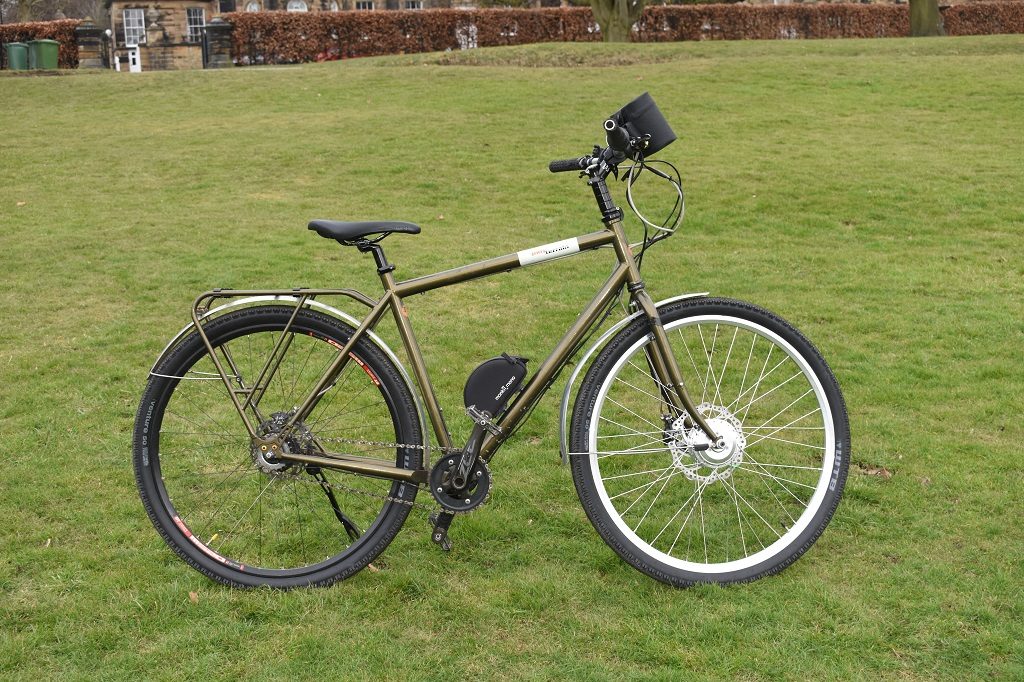
Last Updated: March 17, 2021
Review and photos: Richard Peace
Tested By: Richard Peace
Swytch are a UK-based company and since their formation in 2017 has been on a mission; to produce the most versatile, lightweight retrofit electric assist system out there. They have chosen a straightforward-looking system of front hub motor ready-spoked into a rim, handlebar-mounted battery and controller and a pedal sensing disc to provide motor power when the rider starts pedaling (there is also a throttle option, not tested here).
Swytch’s big selling point is the very wide range of bikes that their kit will convert to electric assist; in fact, they boast they can convert any bike to electric assist with the exception of those whose front wheels feature hub brakes or thru-axles, both relatively unusual designs. They even say the kit can be made to fit most recumbents, trikes and tandems though they request you contact [email protected] to discuss exact details of how it will fit your particular bike if it’s a relatively unusual design like these examples.
It also claims to be the world’s smallest and lightest electric assist kit. Whilst there are a few other kits out there that would contest this claim it certainly is one of the lightest electrification options out there.
Our bottom line on the Swytch retrofit system: Should convert the vast majority of ‘unpowered’ bikes out there to electric assist relatively simply and, if you order in advance, should do it at a great price.
eBike Category: Retrofit Kit – For Most Designs of Bike, Suitable for Road and Trail Use
- Euro / UK spec: Pedelec only, assist to 15.5mph
- US spec: Pedelec or throttle assist to 20mph
Pros:
- Easy to fit on the vast majority of bikes
- The kit overall is lightweight and won’t add too much heft to your bike
- Disc brake compatible
- Zippy motor power with smooth power delivery
- Easy to pedal with no power and without the battery attached
- The removable battery makes for effective theft deterrent
- Two battery options, the larger one including a front light feature
- Walk assist capable
- Affordable pricing to electrify older bikes
Cons/Areas Of Improvement:
- As with any retrofit kit you will need at least basic DIY skills to fit it yourself. That is likely to intimidated some folks, though it’s a straightforward job for any good bike shop if you don’t fancy doing it yourself
- The battery size is somewhat limited
- It doesn’t add too much overall weight, but the weight it does add is a front heavy design
- Battery capacity meter is not the most accurate
- Including a separate power level control button on the handlebars would make for a welcome addition in the future
Swytch Specs & Features
- Battery: Swytch own-brand with 180Wh and 252Wh options
- Control: Battery bag has power controls built into the top of it
- Motor: 250W geared front hub motor
- Lights: Small integrated light built into front of larger battery option
- Pedal Assist: Crank-mounting motion sensor with universal design with throttle option for US version.
- Range: Circa 20-40 miles from 252Wh (larger capacity option) battery
- Motor activation: 5 power levels, set on battery top power control buttons. Pedal motion sensor or throttle control.
Swytch Weight and Dimensions
- Removable battery / controller pack weight: 4.6lbs / 2.1kg (252Wh capacity option)
- Total kit weight: 9.8lbs / 4.45kg
Note this is the effective weight the kit added to the bike calculated by weight the bike before and after the kit was added, not the actual weight of all kit components – weight may be gained or lost by the difference in weight of the new rim, spokes and, where applicable, disc brake rotor. Before fitting the bike weighed 34.5lbs / 15.65kg and after fitting 44.3lbs / 20.1kg giving an overall gain of 9.8lb / 4.45kg.
Fitting the Swytch Electric Bike Kit
What Do You Get?
The Swytch is a front hub motor kit and there are four main components, three of which need to be fitted to the bike to be electrified.
1. Motor wheel. Swytch supply a complete motor wheel in any size that replaces your existing front wheel. The standard offering comprises silver motor, rim and spokes as standard but black is also possible as a ‘customization’ option.
Swytch has standard wheel sizes 28″, 26″ and 16″ (Brompton) in stock available to buy at the full RRP starting at £999 including VAT, from their eBay/Amazon stores
2. Battery pack. This is quickly removable from the bike and also contains the control electronics. My kit came with the larger 252Wh option (180Wh being the standard offering) and the larger battery pack also features a small inbuilt safety light which the smaller option doesn’t.
3. Battery connection block / wiring interface. This clamps around your handlebars and acts as a mount for both the battery and a connection point or the other elements of the system via the waterproof connections that hang underneath it.
The kit comes with a waterproof cover for the battery connection block if the battery is not on and the block is exposed to the weather.
Swytch say you need 9.5cm / 3.75 inches clear space in the middle of your handlebars for battery mounting.
4. Pedal sensor. This is required so that the kit complies with EU law – pedals must be turning for the motor to provide power. US spec kits come with a throttle and the US system is designed to assist up to 30kmh / 18.6mph rather than the 25kmh / 15.5mph of the Euro spec kit that I tested.
The kit is supplied with clear and comprehensive installation instructions too.
Swytch also offer a one year guarantee including quick dispatch of replacement parts, or collection for repair, if anything goes wrong and free live video calls with their qualified engineers based in London.
The ‘Donor’ Bike
Swytch say the kit can be fitted to virtually any bike. I really fancied electrifying my longstanding touring machine, a solidly built German touring bike (a modified Tout Terrain Amber Road) with many high quality parts and eight hub gears that is a joy to ride and on which I’ve done several tours.
However, it hadn’t really been used very much for a while, the attraction of having many e-bikes around the house meaning the Tout Terrain was increasingly less a bike of choice, ending up languishing at the back of the shed. Despite being wonderful to ride it’s fairly heavy, and when loaded up for a tour I felt a lightweight motor system like Swytch would really increase its capabilities. There must be thousands of bikes at the back of sheds right around the world just awaiting for electrification to give them a new lease of life!
The Tout Terrain would also be a good test for the fitting procedure as it is a relatively complex bike to fit a kit to – so if this went smoothly the fitting process for the average ‘donor’ bike would be much simpler. The Tout Terrain featured a front disc brake and external bottom bracket bearings that could be a potential problem area for fitting a pedal movement sensor to. Certainly, not all retrofit kits on the market would be suitable but Swytch’s kit with its new universal design of pedal sensor looked like it would work.
The Fitting Process
One of Swytch’s big selling points is that the kit should be quick to and easy fit and, overall, I definitely found that to be the case.
Swapping out the front wheel meant buying a new disc brake rotor as the old non-electric wheel featured a different mounting (center-lock style) and the new Swytch motor wheel comes set up to accept the more standard six-bolt system. Still, I was relieved to find that the new rotor on the new motor wheel slotted in perfectly to the existing calipers. I also needed to file a little off the shoulders of the axle on the new motor wheel so it would fit the 9mm dropouts – the Swytch standard motor comes ready for 10mm droputs. However, Swytch say they can supply motor wheels to fit the more unusual 9mm dropouts if notified in advance so this step shouldn’t be necessary for others who check this measurement in advance. I might also have requested a black rim to match the existing ones on the Tout Terrain but wasn’t 100% sure which bike I would fit it to when I requested the kit.
Once the wheel is in you then fit a two part sensor to the bike that will detect pedal motion, with one part fitting around the pedal axle (just how depends on your pedal axle design, but Swytch have a universal fitting for all designs) and the other attaching to the bike.
Finally fix on with handlebar mount using the allen bolts and strap supplied before connecting up all component parts with simple push fittings and cable tieing leads neatly along the bike.
All in all it took me around half an hour with a considerable extra chunk of time to film it all! One of the lengthiest jobs was simply to swap the tires over from the old wheel to the new – some tires being easier to get on and off rims than others. All other steps proved even simpler and quicker. I also took a little time to make sure the crank mounted pedal sensor was secured firmly to cranks and aligned closely with the frame-mounted sensor (fitting the US spec that uses a throttle would be even simpler as you would not need to go through the slightly fiddly procedure of fitting the pedal sensor).
The video shows just how I fitted the kit to my particular bike.
Performance Review
Electric Assist Performance
It’s an exciting moment riding off on an assist kit you have just fitted. The motor felt lightweight and just spinning the wheel without the battery switched on promised a nice freerunning freewheel that would be easy to ride even with the power turned off, so all boded well.
I wasn’t disappointed as the motor picked up quickly on pedaling off and was oh so smooth and impressively quiet although not quite silent. There felt to be plenty of torque-like power – good for accelerating quickly from a standing start and hillclimbing.
The control system did its job well too, bringing in the power after about a turn of the pedals from a standing start and cutting out shortly after stopping pedalling.
Whilst the motor was a real star my only real gripe was not being able to easily toggle between the five power levels – these are found on the top of the battery bag and so when cruising along changing the level involves removing a hand from the handlebars. This is fine if on smooth level tarmac but hit a hill or bumps and it’s tricky to change levels as quickly as you want.
The five power levels don’t appear to be customisable either, as they are on some systems. I felt the power in level one was actually a little too much in easy riding conditions and would have opted to tone it down if the levels had been customizable. I’m being pretty picky here though – the Swytch is all about simplicity of fitting and use and it achieves that goal well.
The battery capacity meter is pretty useful but only as an approximation of charge level left; on my 26.4 mile range test ride lights went out at around 5.5miles, 11 miles, 13 miles and 17 miles and the 5th light never actually went out – power just stopped being delivered shortly after the 26 mile mark.
There is a walk assist feature that was useful when negotiating inclines that need you dismount and push the bike up, such as very narrow trail access ramps.
The wide range of the eight speed gears on the Tout Terrain worked extremely well with the power delivery system, allowing me to keep the pedals spinning quite quickly and power to keep coming as a gentle but firm, almost silent push.
I also rode the bike around in a reasonably high gear (topping out at 18mph on the flat) without changing gear to try and mimic how it might feel on a single speed as I thought it would also make a good addition to a lightweight single-speed e-bike. This worked pretty well and I managed to tackle some fairly steep hills in the single high gear. So, a tentative conclusion is that it would also be a nice kit to fit to a light single speed.
Effect of Adding the Kit on Riding
A concern before fitting the kit was how the extra weight of the battery on the handlebars would affect the stable and predictable handling of the bike. However, the extra 4.6lbs / 2.1kg of the battery pack on the bars wasn’t really noticeable whilst riding – the effect was felt more when of the bike as it tends to quickly swivel the bars to one side, so some care was needed when leaving it propped on the kickstand. This might well be different when adding the heavier battery back to a bike with small wheels though, as these are inherently more noticeably and quickly affected by any turning forces applied to them. My Tout Terrain has large 28” wheels with fairly large volume tyres which no doubt helped stability, even with the battery pack on.
The bike was still easy to ride with motor power turned off too, meaning the averagely fit rider shouldn’t have too much of a problem if they inadvertently run out of battery a few miles from home and need to pedal back unpowered.
Range & Hill Climb Test
I tested the Swytch kit over a range of tracks and roads you might find on a typical tour, taking in paved cycle lanes, regular roads and unmetalled tracks and trails including railpath and forest tracks. The latter were generally good quality with the occasional muddy section due to late winter rain. I was impressed that the pedal sesnor kept on working even when it got coated in mud. I covered several sections of the UK’s Trans Pennine Trail – a largely off-road ‘challenge’ trail suitable for all abilities of rider with the majority of the trail on unsurfaced, traffic-free tracks and path suitable for family riding. Overall it would be best described as moderately hilly, involving 1815ft of ascent over the whole test circuit.
I achieved a range of 26.4 miles in blustery conditions of about 9 degrees centigrade in late winter. This is pretty good for a heavyish touring bike with gravel-treaded tyres and plenty of off-road riding and in cool, windy weather – any system that uses less than 10Wh per mile over my moderately hilly testing ground I would regard as economic with the power.
Hill Test
Swytch say ‘Our compact motor has enough pulling power to assist the average adult up a steep 30% incline easily, thanks to our tuned controller algorithm’
My standard hill climb test certainly confirmed that it was a proficient hill climber. The test takes in around 0.8 miles of continuous climbing with a couple of short 20% gradients. The Swytch system tackled in it three minutes and two seconds, meaning it maintained a speed pretty close to the max assisted speed of 15.5mph for much of the way. Only on the 20% gradients did the speed drop down to around 14mph.
That’s impressive – not quite up to the standard of the most powerful Bosch motors which can maintain full assisted speed all the way up but certainly in the upper echelons of all the hub powered e-bikes I have tried up the same climb.
Extras and Options
Should you go for the lighter 180Wh battery pack or the heavier 252Wh pack? Clearly that depends on what kind of range you want, but also note the more stable and predictable the handling of the bike you are fitting the kit to the more likely it is handling will be relatively unaffected by adding the large battery – larger wheels and large volume tires usually help in this regard. Smaller wheeled bikes may be more at home with the lighter 180Wh pack (note this is used by Swytch on their Brompton specific kit, the Brompton using small 16” wheels).
On my kit there were three extra unused connections at the bottom of the battery pack designed for throttle and inline brake sensors which are both offered as options.
The beefy-looking torque washers on the motor axle are sufficient for the vast majority of retrofits say Swytch but they recommend a full torque arm for lighter, more flexible carbon forks.
Summary Review & Where to Buy
The Swytch kit is light, pretty easy to fit and cost-effective – what’s not to like? The small front hub motor gives lively performance, particularly impressive for its small size and weight, and battery range is also good, indicating a pretty efficient system. The only thing I would have really appreciated is a separate power level control button next to a handlebar grip rather than on top of the battery.
If you want brute power from a larger retrofit motor or really need a larger capacity battery you might want to look elsewhere, but otherwise the Swytch retrofit kit should certainly be near the top of your list if you are heading down the retrofit route.
The fact that this is a company that has concentrated solely on retrofit kits for several years now is also encouraging and suggests you should get good and continuing after sales support.
Available directly from Swytch at swytchbike.com and on their EBAY store (Amazon store forthcoming) at the following prices, with up to 50% discount if customers register to pre-order in one of Swytch’s pre-order windows (note Swytch ship to the UK, EU and USA with very competitive shipping rates via next-day couriers like DPD or Fedex. They say they can also ship to the rest of world but significant additional charges for air-freight will apply). The Eco kit ships with the 180Wh battery and the Pro with the 252Wh battery. The following prices include UK VAT but do not include shipping and duties for the US and EU.
Eco Pro
UK£ 999 1250
US$ 999 1249
EU€ 950 1200
There is a Brompton specific Swytch kit and prices are slightly higher for this.
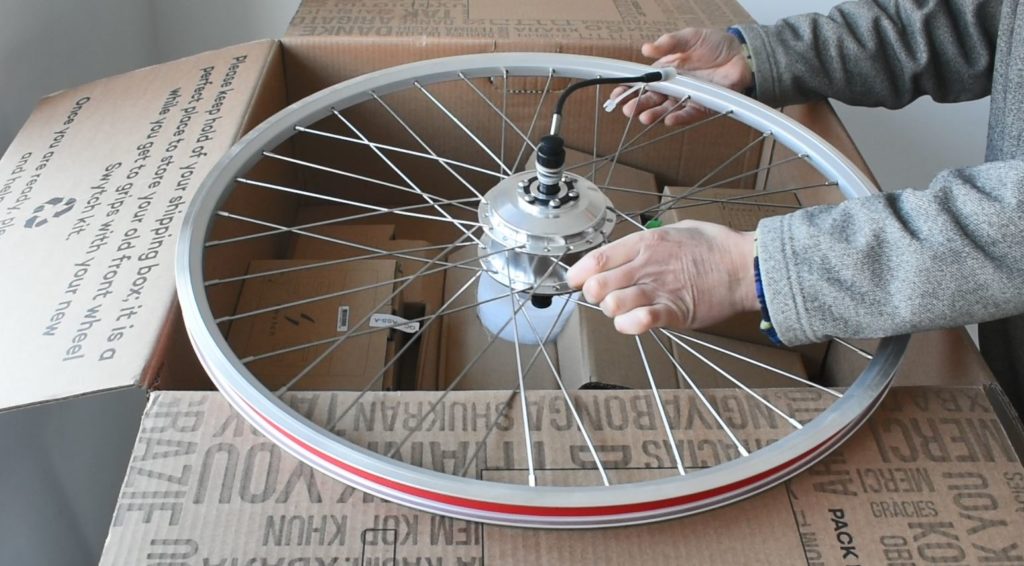
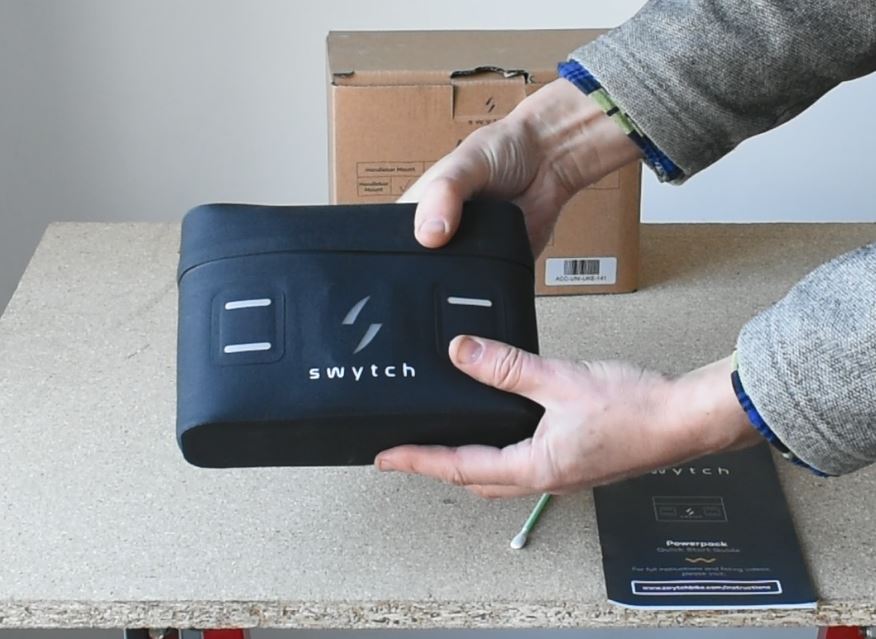
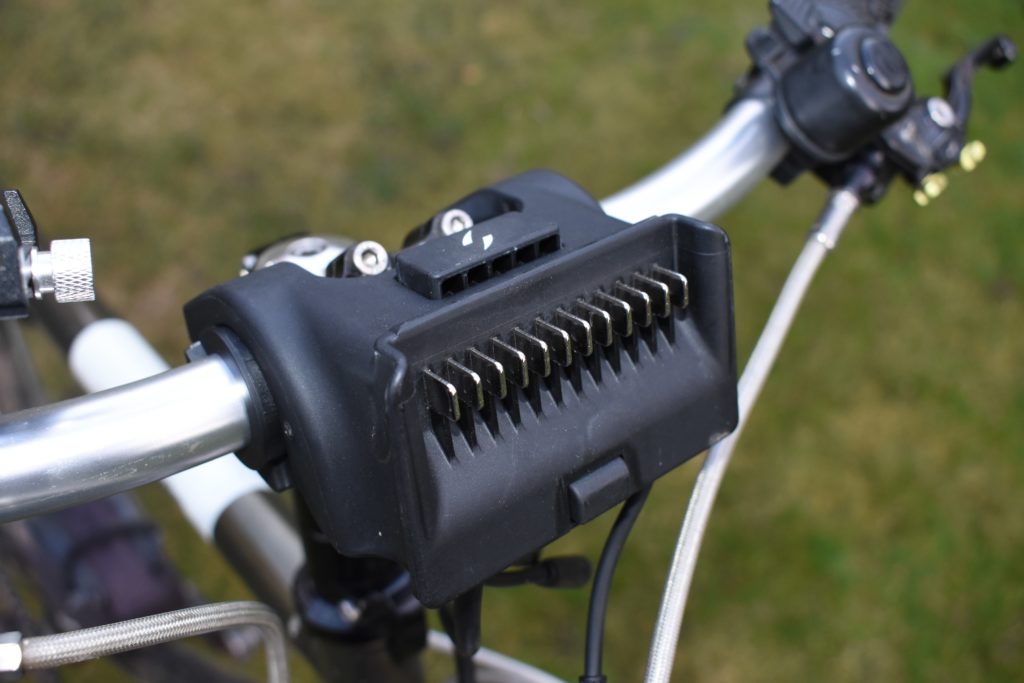
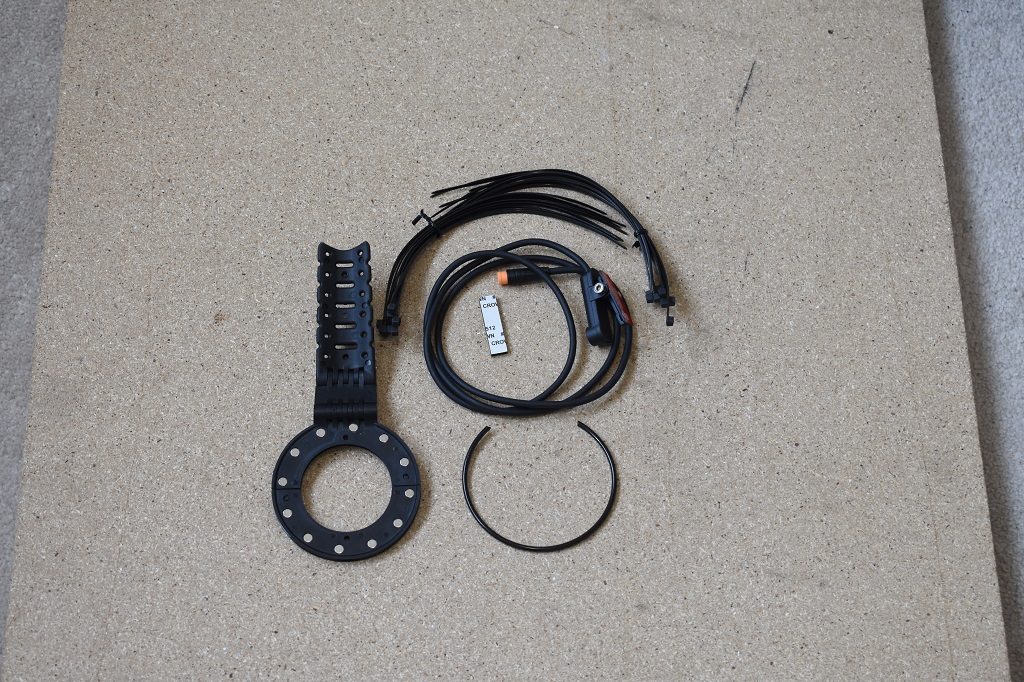
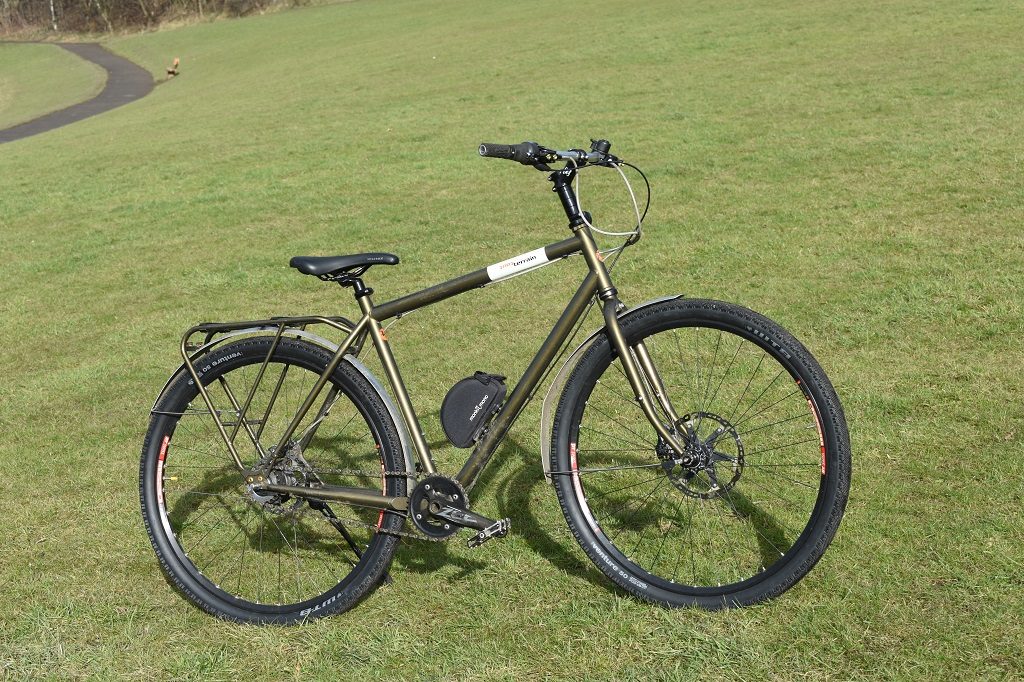
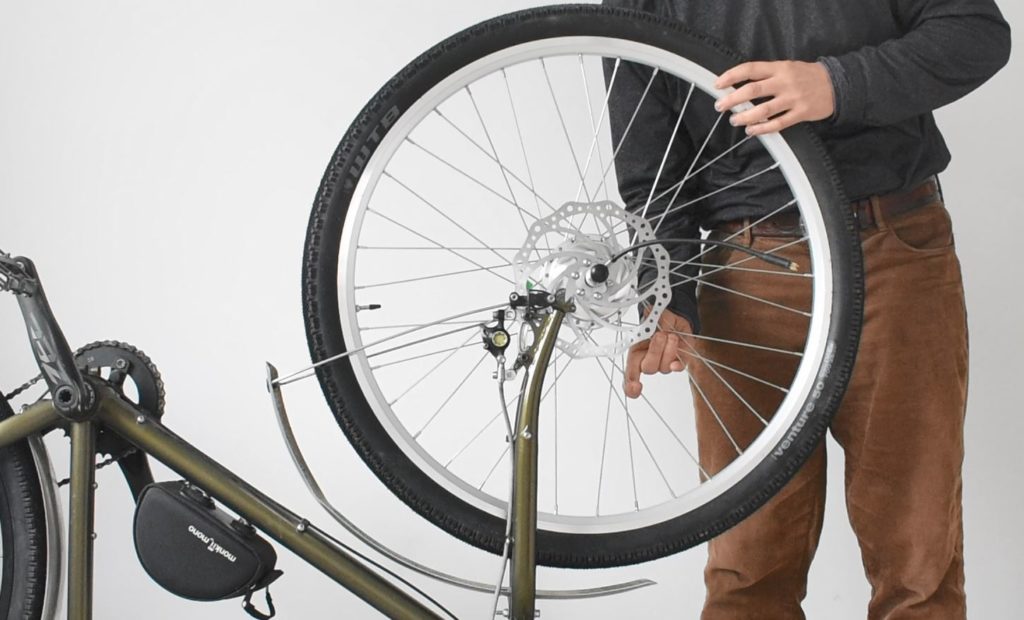
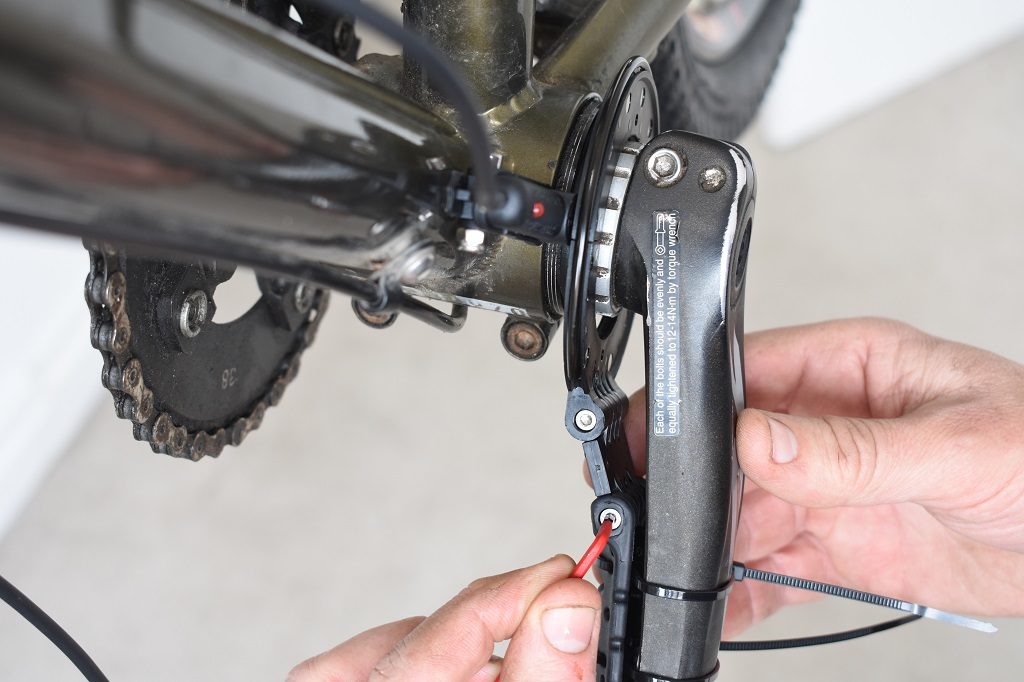
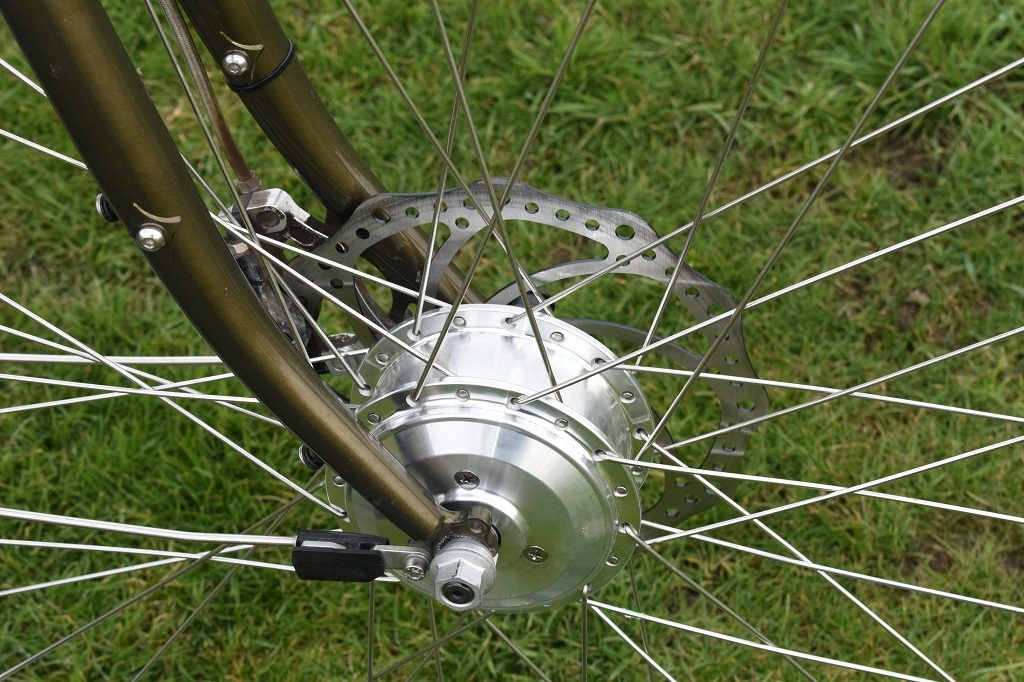
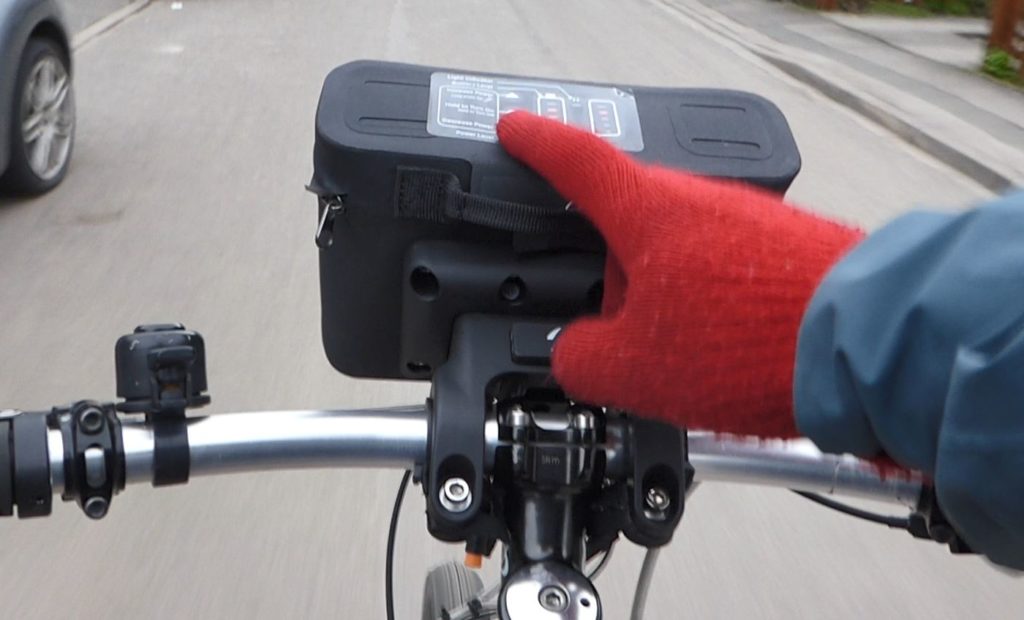
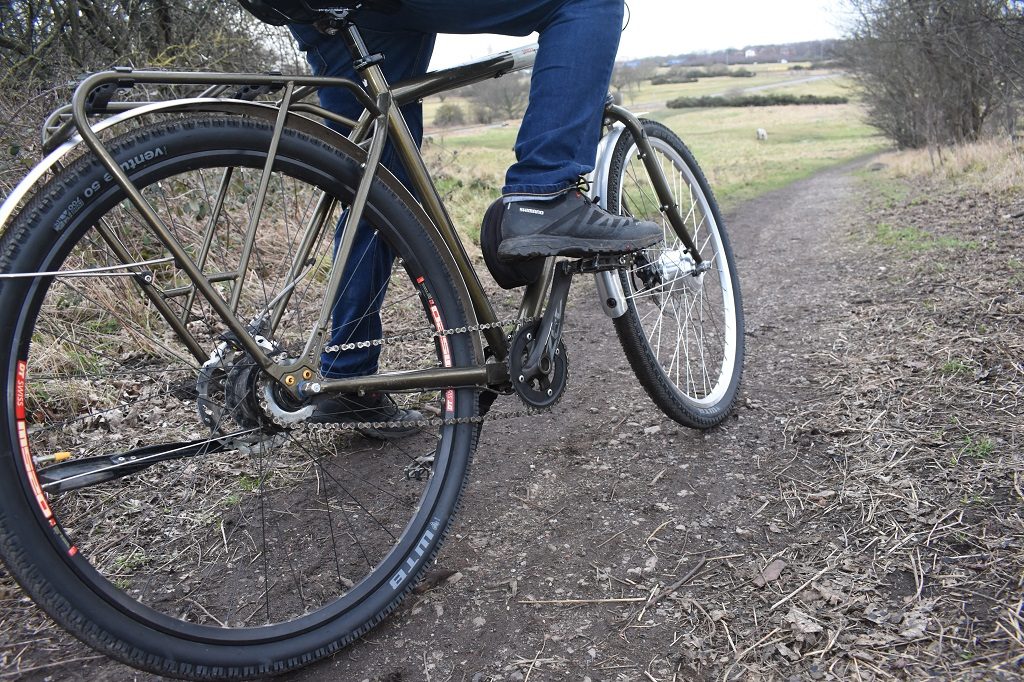
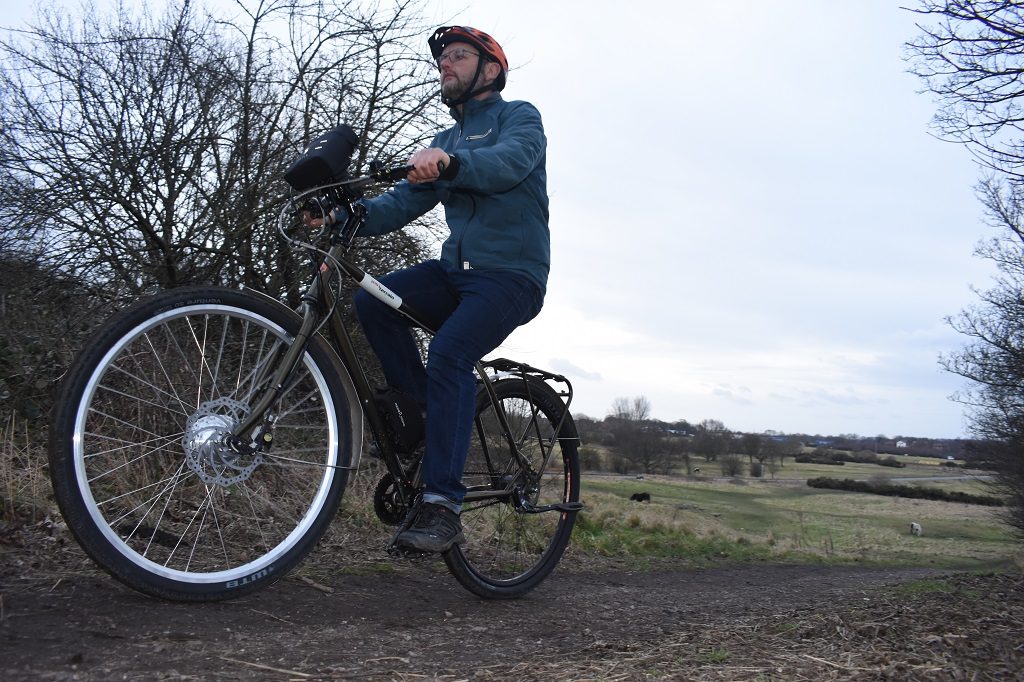
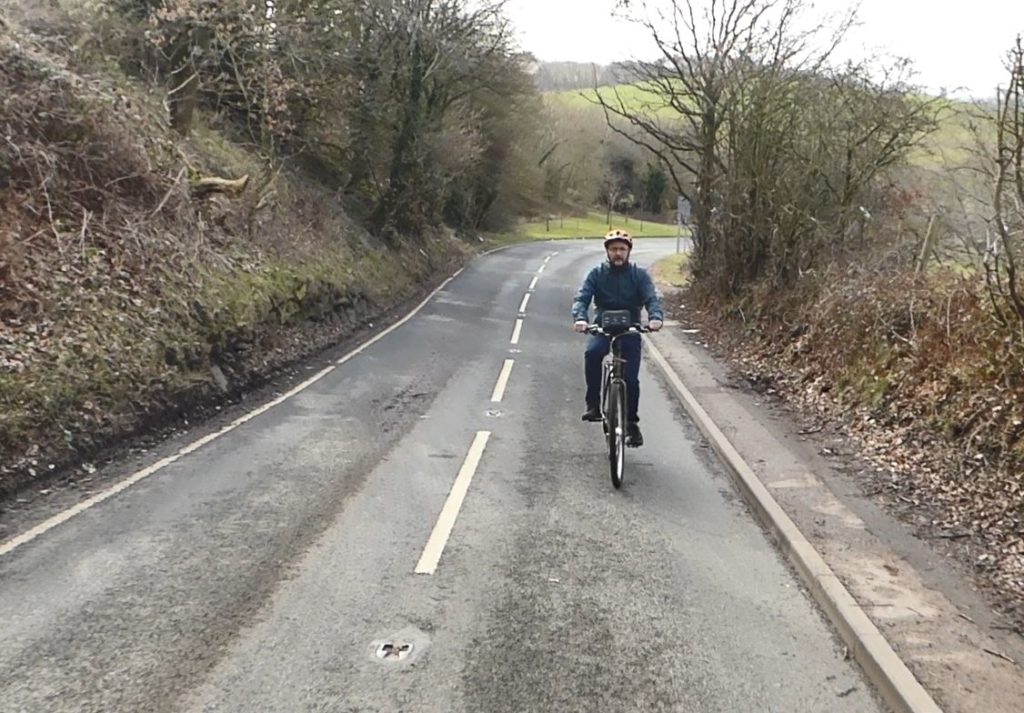
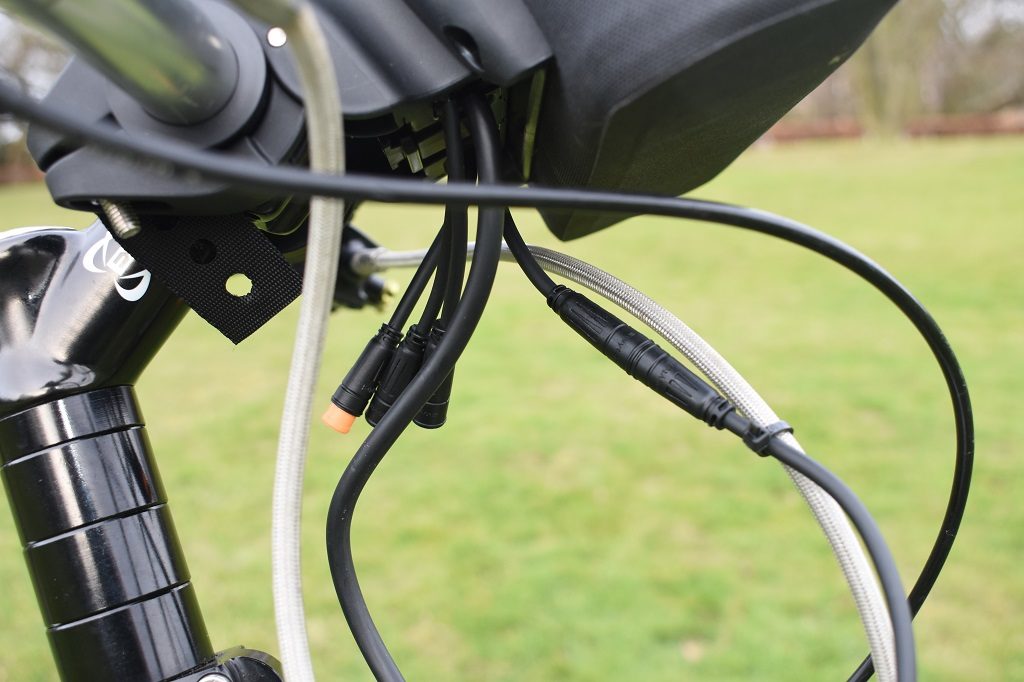
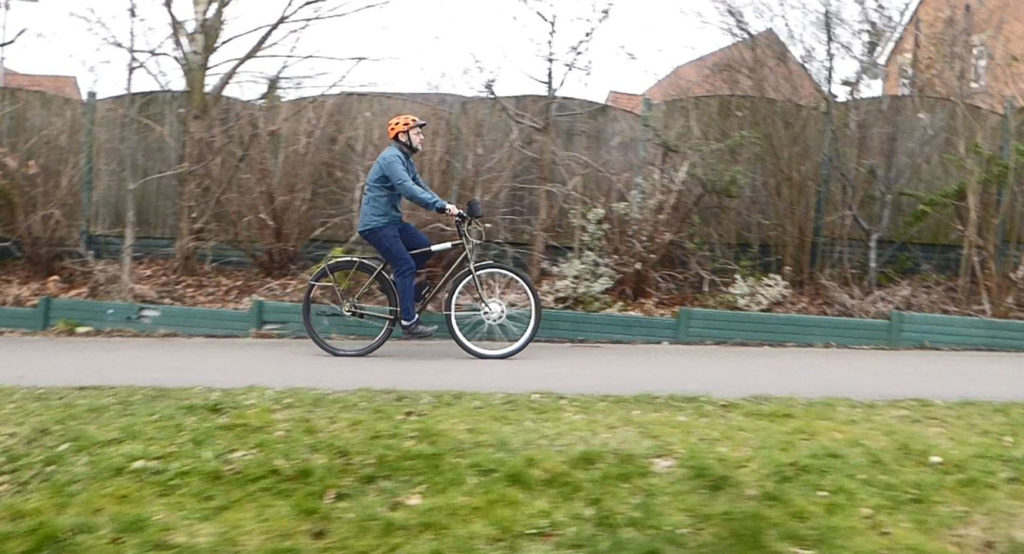



The Swytch Kit works fine on my two wheel recumbent bike.
https://members.efn.org/~hkrieger/SwytchKit.jpg
I just fitted a kit to my city urban bike and it’s great. Took me about 1-1/2hrs inc fitting the thumb throttle and brake sensors. The only pain was the time between ordering and arrival – in my case 8 months ! Swytch are poor at communicating what is going on in delivery but that’s all I have to say about it. Be prepared to wait.
So far, I like my new wheel – however, it is important to note that the wheel is not universal, as promised. I believe that the company needs to do a better job advising people of about using this wheel on carbon fibre bikes. I was advised by my bike shop to not install this wheel on carbon forks (Swytch later confirmed) so I first had to purchase a new steel fork at $200 which has also made the front end of my bike heavier (now with the wheel I am very front end heavy and am concerned about stability.) Secondly, since the joints on the carbon frame are not square as in other bike frames, but flared, the sensor would not fit. Swytch was unable to find a resolution and concluded that they had run of suggestions for my bike and that it may not be suitable (clearly this is not universal). It took considerable research and money spent for me to find a resolution, but at this point I am uncertain if the sensor will hold long-term.
Finally, as others have mentioned, to say that the delivery time promise was optimistic is an under-statement. It took 9 months for my wheel to arrive. I agree that Swytch was very poor at communicating and I generally only received a delivery update when I made the request.